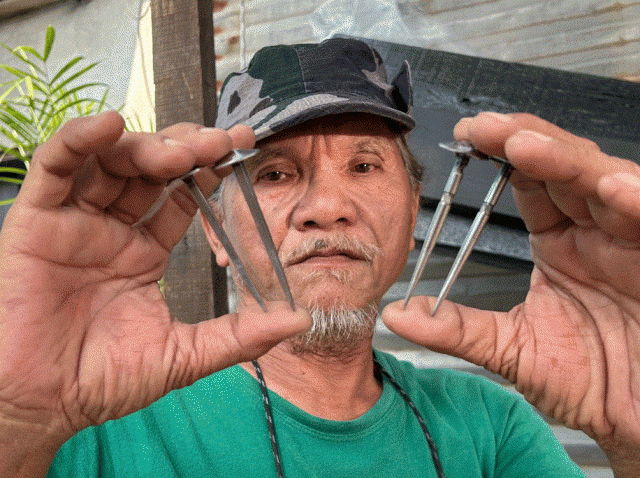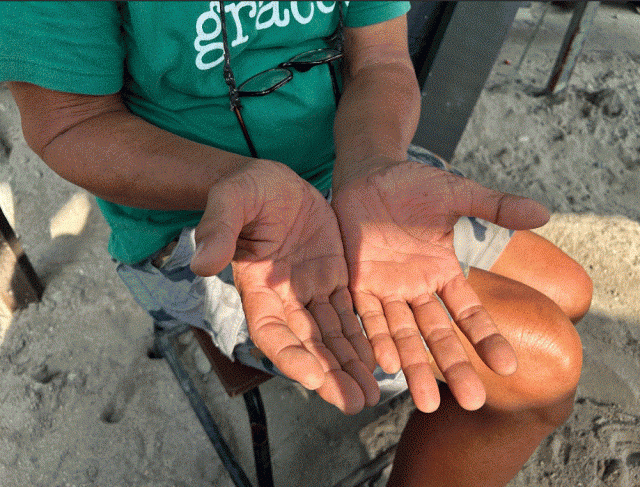A cross too heavy to pass on? Ruben Enaje fears end of panata in Cutud

PAMPANGA —In the sweltering heat of San Pedro Cutud, Pampanga, where the scent of incense fills the air and the murmur of prayers echoes, a man prepares for an extraordinary and painful ritual.
Ruben Enaje, a soft-spoken 64-year-old construction worker, has been carrying a cross and enduring crucifixion every Good Friday for 35 years.
Enaje’s act of devotion, though controversial to some, has become a fixture in Filipino Holy Week tradition, drawing crowds from around the world to witness his peculiar sacrifice.
As he prepares for his 36th crucifixion, there’s an undeniable sense of unease in his voice—a subtle fear that the very tradition he has become known for may one day disappear, never to be seen again.
There used to be as many as 44 ‘kristos’ who took part in the Holy Week tradition in Pampanga. This year, Enaje said they’re down to three.
“Hindi na sila interesado sa ganitong tradisyon,” Enaje rued.
A miracle, a promise, and a lifelong vow
In an interview days before the annual San Pedro Cutud Lenten rites, a Holy Week reenactment of Christ’s passion and death, Enaje recalled why he decided to don the crown of thorns and carry the cross.
His story began not with a desire for recognition or fame but was driven by an overwhelming gratitude for a miracle.
It was 1985, when Enaje was just 25 years old and working in a construction site when he fell from a height of 30 feet after the bamboo scaffolding they were using caved in.
“Akala ko, mamamatay na ako. Pero nang mabangga ako, tinanong ko, ‘Bakit ako buhay pa?’” he said.
He became unconscious for a few minutes then he was suddenly awake and found out he had barely a scratch.
Enaje felt something was stirred within him—an overwhelming sense of gratitude. At that moment, he believed that God had spared his life for a reason. Determined to honor this second chance, Enaje made a promise.
He vowed that every Good Friday, he would reenact the suffering of Christ by carrying the cross and undergoing crucifixion.
“Sabi ko sa sarili ko, kung buhay pa ako, magpapako ako sa krus para sa Diyos. Iyon ang magiging pasasalamat ko,” he said.
What began as a promise of faith soon became an annual tradition, drawing attention from the local community and eventually, the world. Enaje’s first crucifixion was an act of gratitude, but it soon transformed into something much deeper.
One thing Enaje didn’t anticipate was the bond this act would create with the people who witnessed it and the growing sense of responsibility he would feel to continue the tradition year after year.

The weight of the cross
Year after year, Enaje walked the same painful path, bearing the cross through the streets of San Pedro Cutud under the burning midday sun. The ritual itself is excruciating—first, he carries a wooden cross, then he is nailed to it with large steel nails, his body suspended as the crowd watches in awe.
“Gusto ko na talagang tumigil.”
His reason is simple and human: “Sa edad natin, 65 na ako niyan sa July. Yung bigat ng cross nararamdaman ko na.”
For Enaje, however, it is not the physical pain that defines the experience. “Sakit. Sobrang sakit, pero hindi ko iniisip ‘yun. Ang mahalaga, ang mensahe,” he shared.
“Dati, kaya ko pa. Ngayon, sobrang sakit. Pero hindi ko kayang bitawan ‘to. Ito na ang misyon ko,” he added with a quiet resolve.
It is not just the body that suffers; the mind, too, bears the weight of his commitment.
“Noong una, tahimik lang ako. Ginawa ko ito para sa Diyos at para sa sarili ko. Pero ngayon, napansin ko, may pressure na. May mga tao na nagmamasid, at minsan, iniisip ko kung tama pa ba na magpatuloy,” Enaje reflects, his eyes clouded with the uncertainty of the future.
Though deeply committed to his devotion, Enaje wonders whether the tradition will remain after he gets crucified for the last time.
The ritual is not only painful but isolating. He knows that most of his fellow Filipinos, especially the younger generation, no longer share the same dedication to the faith. The tradition that once had so many men willing to take up the cross has dwindled significantly.
“Noong unang taon ko, may mga 44 na kami na nagdaos ng crucifixion. Ngayon, konti na lang,” he said, his voice tinged with sorrow.
The decline of a tradition
As Enaje reflects on the decline of the tradition, his concern is palpable. He knows that younger generations, distracted by modern life, are increasingly indifferent to the religious practices that once defined their community.
“Hindi na sila interesado sa ganitong tradisyon,” he said. “Parang hindi nila na-appreciate ang hirap na dinadanas ko.”
In 1985, when Enaje first took up a cross, many men from San Pedro Cutud joined him in the reenactment of Christ’s passion. But now, fewer and fewer men are willing to undergo the ritual. He fears that he may soon be the last to carry the cross.
“Wala nang papalit sa akin. Kung wala nang magpapatuloy, mawawala na ang tradisyon,” he said with a heavy heart.
The fear of the tradition’s demise is not just a personal concern but a collective one. For Enaje, the ritual is not simply about physical suffering—it’s about faith, community, and a deep connection to God.
“Ang sakripisyo ay hindi lang para sa akin. Para ito sa mga tao, para sa komunidad namin. Kung wala ang tradisyong ito, parang mawawala na rin ang koneksyon namin sa Diyos,” he said.
There are moments, too, when Enaje feels the weight of public attention on his shoulders.
“May mga tao na tinatawanan kami. Sa akin, masakit yung loob ko pero dahil may panata natin ito, kahit gaano pa kahirap, iintindihin na lang natin yung ano, yung tao na mga tumatawa. May iba nagsasabi, nagyayabang daw ako, hindi daw ito totoo, umaarte lang,” he lamented.
While many revere him as a symbol of unwavering faith, others criticize him, calling the act barbaric and unnecessary. But Enaje’s faith remains unshaken.
“Hindi nila alam, may malalim na dahilan ang ginagawa namin. Hindi ito laro. Pero para sa akin, tuloy-tuloy lang yung dasal, lahat pang papunta sa cross, sa burol,” he said, giving the scene of the “crucifixion” a steady gaze.

‘Popular religiosity’
Fr. Paul Reagan Talavera, OP of the UST Santisimo Rosario Parish, who recently ended his six-year term as parish priest, shared insights on how the Catholic Church views crucifixion reenactments in places like Pampanga.
“These could be considered popular religiosity or piety, and as such, are personal expressions of faith,” Fr. Talavera explained.
While the Church does not formally endorse such dramatic reenactments, it recognizes the personal devotion behind them.
He emphasized that the Church offers other ways to commemorate the passion and death of Christ, especially during Holy Week.
"We have Holy Week liturgy where the faithful can participate, such as the Easter Triduum, Stations of the Cross, receiving the Sacrament of Confession, fasting and abstinence, and also popular devotions like Visita Iglesia,” he noted.
Fr. Talavera also highlighted that while some devotees engage in crucifixion rites as acts of penance or thanksgiving, there are sacraments meant specifically for these intentions.
"There is a thing in Filipino we call panata, and this is done annually to give thanks or to ask for a particular intention. However, if we talk about thanksgiving and penance, we have as a Church the sacraments of the Holy Eucharist (thanksgiving) and Reconciliation (penance) that give us grace directly from God,” he pointed out.
Asked whether he sees the tradition of crucifixion reenactments as a fading one—especially with long-time devotee Ruben Enaje noting that only a few remain from the original 44 crucified in 1986—Fr. Talavera responded plainly: “Yes.”
Family, faith, and the legacy
Enaje’s unwavering commitment to the crucifixion has not come without personal sacrifice. His family has supported him throughout the years, but it has not been without struggles.
“Masakit para sa pamilya ko. Alam nila na mahirap para sa akin, pero hindi nila ako pinipigilan. Alam nila na ito ang panata ko,” Enaje said. His wife and children have always understood the depth of his faith, even if they worry about the toll it takes on his body.
“Ipinanganak kami sa Cutud, at alam ng pamilya ko kung gaano kahalaga ang tradisyong ito. Pero ayaw ko ring makita silang mag-alala sa akin. Pero ‘yun na nga, walang ibang susunod,” he said.
Enaje admits, the sadness in his voice growing more apparent. The tradition that has shaped his life may soon vanish, and with it, the sense of purpose that has driven him for so long.
Despite these worries, Ruben refuses to abandon his vow. “Hangga’t kaya ko, magpapatuloy pa rin ako. Ipinagdasal ko na sana may magpatuloy nitong tradisyon, kahit hindi taga-Cutud,” he said, the weight of his words reverberating in the silence that ensued.
The question of what happens after Enaje is gone hangs heavy in the air. Will anyone take up the cross? Will the tradition of crucifixion survive? Enaje fears that the answer is no.
“Sana may magpatuloy,” he said, his voice trailing off as if lost in the depths of his thoughts. “Kung hindi, magdasal tayo na kahit sa ibang lugar, ipagpatuloy nila ang tradisyong ito.”

A message to the next Kristo
Still, he hangs on to hope. And to whoever may one day step into his place—to the next man who dares to carry the same burden, to feel the nails, to embody Christ in ritual—Enaje has something to say.
“Pagka nagpasan na siya ng krus… huwag siyang masyadong mayabang. Pilitin niyang huwag maging abusado sa kanyang buhay. Kailangan maging humble siya. Pilitin niyang maging sa mga tao na para siyang talaga si Kristo na buhay, tinitingala,” Enaje said.
“Kasi dito na naumpisaan sa buong mundo na. Sa ibang bansa meron din, pero hindi ganito,” he says. “Parang pakonti na ng pakonti kaya parang nakakatakot na para kung mamatay yung tradisyon.”
The cross endures
As Enaje moves up to the cross this Good Friday, the crowd will watch anew in reverence. He will once again endure the pain, the humiliation, and the burden of the tradition he carries.
For Enaje, it is more than just a ritual—it is an expression of faith that transcends pain, a profound connection to God, and a legacy that may soon fade into the past.
But for as long as he is able, Enaje said he would continue to bear his cross, offering his suffering for others, just as Christ did. And though he may fear the end of the tradition, one thing is certain: Enaje’s devotion will live on in the hearts of those who have witnessed his sacrifice and in the memories of a tradition that once brought together an entire community in devotion to faith. —LDF/NB/KG, GMA Integrated News





